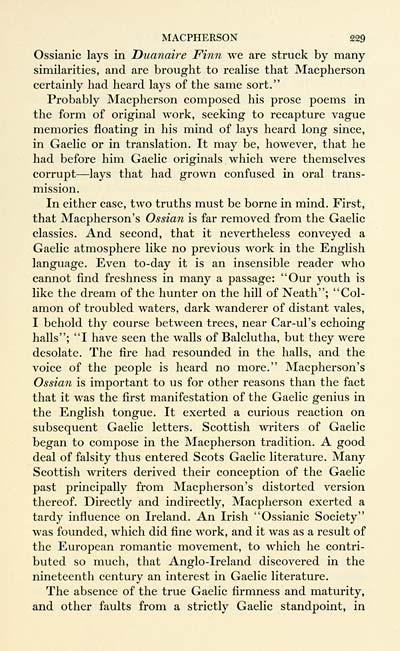Ossian Collection > Scottish eccentrics
(245)
Download files
Complete book:
Individual page:
Thumbnail gallery: Grid view | List view

MACPHERSON 229
Ossianic lays in Duanaire Finn we are struck by many
similarities, and are brought to realise that Macpherson
certainly had heard lays of the same sort."
Probably Macpherson composed his prose poems in
the form of original work, seeking to recapture vague
memories floating in his mind of lays heard long since,
in Gaelic or in translation. It may be, however, that he
had before him Gaelic originals which were themselves
corrupt — lays that had grown confused in oral trans-
mission.
In either case, two truths must be borne in mind. First,
that Macpherson 's Ossian is far removed from the Gaelic
classics. And second, that it nevertheless conveyed a
Gaelic atmosphere like no previous work in the English
language. Even to-day it is an insensible reader who
cannot find freshness in many a passage: "Our youth is
like the dream of the hunter on the hill of Neath"; "Col-
amon of troubled waters, dark wanderer of distant vales,
I behold thy course between trees, near Car-ul's echoing
halls"; "I have seen the walls of Balclutha, but they were
desolate. The fire had resounded in the halls, and the
voice of the people is heard no more." Macpherson's
Ossiaii is important to us for other reasons than the fact
that it was the first manifestation of the Gaelic genius in
the English tongue. It exerted a curious reaction on
subsequent Gaelic letters. Scottish writers of Gaelic
began to compose in the Macpherson tradition. A good
deal of falsity thus entered Scots Gaelic literature. Many
Scottish writers derived their conception of the Gaelic
past principally from Macpherson's distorted version
thereof. Directly and indirectly, Macpherson exerted a
tardy influence on Ireland. An Irish "Ossianic Society"
was founded, which did fine work, and it was as a result of
the European romantic movement, to which he contri-
buted so much, that Anglo-Ireland discovered in the
nineteenth century an interest in Gaelic literature.
The absence of the true Gaelic firmness and maturity,
and other faults from a strictly Gaelic standpoint, in
Ossianic lays in Duanaire Finn we are struck by many
similarities, and are brought to realise that Macpherson
certainly had heard lays of the same sort."
Probably Macpherson composed his prose poems in
the form of original work, seeking to recapture vague
memories floating in his mind of lays heard long since,
in Gaelic or in translation. It may be, however, that he
had before him Gaelic originals which were themselves
corrupt — lays that had grown confused in oral trans-
mission.
In either case, two truths must be borne in mind. First,
that Macpherson 's Ossian is far removed from the Gaelic
classics. And second, that it nevertheless conveyed a
Gaelic atmosphere like no previous work in the English
language. Even to-day it is an insensible reader who
cannot find freshness in many a passage: "Our youth is
like the dream of the hunter on the hill of Neath"; "Col-
amon of troubled waters, dark wanderer of distant vales,
I behold thy course between trees, near Car-ul's echoing
halls"; "I have seen the walls of Balclutha, but they were
desolate. The fire had resounded in the halls, and the
voice of the people is heard no more." Macpherson's
Ossiaii is important to us for other reasons than the fact
that it was the first manifestation of the Gaelic genius in
the English tongue. It exerted a curious reaction on
subsequent Gaelic letters. Scottish writers of Gaelic
began to compose in the Macpherson tradition. A good
deal of falsity thus entered Scots Gaelic literature. Many
Scottish writers derived their conception of the Gaelic
past principally from Macpherson's distorted version
thereof. Directly and indirectly, Macpherson exerted a
tardy influence on Ireland. An Irish "Ossianic Society"
was founded, which did fine work, and it was as a result of
the European romantic movement, to which he contri-
buted so much, that Anglo-Ireland discovered in the
nineteenth century an interest in Gaelic literature.
The absence of the true Gaelic firmness and maturity,
and other faults from a strictly Gaelic standpoint, in
Set display mode to: Large image | Transcription
Images and transcriptions on this page, including medium image downloads, may be used under the Creative Commons Attribution 4.0 International Licence unless otherwise stated. ![]()
| Early Gaelic Book Collections > Ossian Collection > Scottish eccentrics > (245) |
|---|
| Permanent URL | https://digital.nls.uk/81911284 |
|---|
| Description | Selected books from the Ossian Collection of 327 volumes, originally assembled by J. Norman Methven of Perth. Different editions and translations of James MacPherson's epic poem 'Ossian', some with a map of the 'Kingdom of Connor'. Also secondary material relating to Ossianic poetry and the Ossian controversy. |
|---|
| Description | Selected items from five 'Special and Named Printed Collections'. Includes books in Gaelic and other Celtic languages, works about the Gaels, their languages, literature, culture and history. |
|---|

